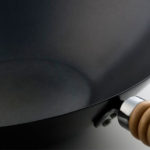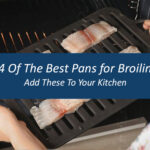Do All Non Stick Pans Have Teflon? Not at all

Nonstick pans are very easy to clean and use, as they are designed to prevent food from sticking to the surface. Due to their non-sticking properties, nonstick pans are best for cooking items such as eggs and pancakes. But the question is, do all nonstick pans have Teflon?
The answer to this question is: it depends. Not all non-stick pans have Teflon, but many do. Teflon is a brand name for polytetrafluoroethylene (PTFE), which is a type of synthetic polymer used to coat surfaces to make them non-stick.
In general, Teflon is known to be the most durable of all non-stick coatings and is less expensive than other options.
Some companies use other coatings such as ceramic, anodized aluminum, and silicone. So while some non-stick pans may contain Teflon, it is not the only option available.
If you’re looking for a nonstick pan without Teflon, it’s important to read the product label to see what type of coating it has. Some coatings are better than others at resisting scratches and heat.
When using Teflon pans, the temperature should not exceed 500F (260C) and they should always be used with plastic, wood or silicone utensils to avoid scratching and flaking of the coating. Other types of non-stick pans may have their own temperature limits, so it is important to read the instructions carefully before use.
Overall, not all non-stick pans have Teflon, but many do and it is an important factor to consider when purchasing a pan. Be sure to read the label, know your temperature limits and use the appropriate utensils in order to get the most out of your non-stick pan.
What is Non-Stick?
The term “non-stick” refers to a material’s ability to resist sticking to other surfaces or itself. This is typically achieved by applying a coating to the surface of the material.
Non-stick coatings are often used on cookware, as they allow food to be cooked with less oil and make cleanup easier.
How does Non-Stick work?
Non-stick coatings work by reducing the surface tension of the material, which prevents other materials from bonding to it. The coating also makes the surface smoother, which helps to prevent sticking.
However Non-stick coatings can be damaged by scratches or abrasion, which can cause them to lose their non-stick properties.
Over time, the non-stick coating can also begin to flake off, which makes it more likely to stick.
However, if used properly, it can be a great way to reduce the amount of oil needed for cooking and make cleanup easier.
What comes under non-stick?
If we talk about the nonstick coating then we have Teflon, Ceramic, and anodized aluminum. All of these have their own properties which make them different from one another.
Teflon
Teflon is one type of nonstick coating for cookware. Many brands have their own version of nonstick coating. While Teflon is a popular option, it’s not the only one.
The most common type of non-stick coating is polytetrafluoroethylene (PTFE), which is sold under the brand name Teflon. PTFE coatings are made by bonding PTFE molecules to the surface of the material.
PFOA, or perfluorooctanoic acid, is a synthetic chemical that has been used in the manufacturing of non-stick coatings since the 1940s. It is also a key ingredient in Teflon.
Teflon is used in pans because it has a very low coefficient of friction. This means that it is very slippery and does not stick to things easily. It is also resistant to chemical attacks and has a very high melting point.
When non-stick coatings(Teflon) are heated, they release fumes that can be harmful to birds and small animals. For this reason, it is recommended that cookware with non-stick coatings(Teflon) be used in well-ventilated areas.
What are the alternatives to Teflon?
If you want to avoid using Teflon, there are several other options available. Ceramic, Cast Iron, Carbon Steel, and anodized aluminum are the best alternatives.
Ceramic
Another and most famous coating is ceramic. This is a kind of nonstick that doesn’t use any chemicals in its composition, only natural minerals.
Ceramic coatings are made from inorganic materials, such as silicon oxide or aluminum oxide. These materials are bonded to the surface of the cookware to create a non-stick finish.
Ceramic coatings are generally considered to be safe, as they do not contain PFOA or other harmful chemicals. However, they may not be as durable as other types of non-stick coatings and can be more susceptible to scratches and wear.
If you choose to use ceramic cookware, be sure to use gentle cleaning methods and avoid using metal utensils, as they can damage the coating.
Anodized aluminum
Anodized aluminum is a type of aluminum that has been treated to create a durable, non-stick surface.
The anodization process involves electrolytically oxidizing the surface of the aluminum. This creates a layer of aluminum oxide that is bonded to the surface of the metal.
Anodized aluminum cookware is safe to use as it is PFOA and PTFE-free. However, it is not dishwasher safe and should be hand washed to avoid damage to the coating.
Cast Iron
Cast iron is yet another great alternative to nonstick cookware. It is a heavy-duty material that can last for decades with proper care.
Cast iron cookware is made by pouring molten iron into molds. This creates a very strong and durable cookware that is difficult to damage.
Cast iron has a natural non-stick surface that is created by the oils that are added to the iron during the manufacturing process(Pre Seasoned).
However, to keep the non-stick surface in good condition, it is important to season the cookware regularly. This involves coating the cookware with oil and heating it until the oil polymerizes.
Carbon Steel
Do you know about carbon steel? It is also a good alternative to nonstick cookware.
Carbon steel is an alloy of iron and carbon. It is similar to cast iron but with a lower carbon content.
This makes it less brittle and more malleable. Carbon steel cookware is often used in professional kitchens as it has a very high heat tolerance.
Why do people use Teflon then?
If Teflon is not good for health and when we have a lot of alternatives then why do people still use it?
The main reason is that Teflon is very cheap and it works well. Ceramic and anodized aluminum is more expensive and not everybody can afford them.
However, Teflon is not always dangerous or unhealthy. If you use it in low temperatures, like when you fry an egg, the risk is very low.
The problem comes when you use it in high temperatures. In that case, the Teflon can start to emit toxins that can be dangerous for your health.
So, if you are going to use Teflon, try to use it in low temperatures.
Do All-Clad nonstick pans have Teflon
All-Clad is a famous brand with a line of different types of cookware and one of them is the NS1 nonstick pan.
All-Clad NS1 Nonstick Fry Pan is made with a thick aluminum core that heats quickly and evenly, eliminating hotspots. This cookware is made of PFOA-free PTFE(Teflon) nonstick coating.
What are the benefits of nonstick cookware?
The main benefit of nonstick cookware is that it allows food to be cooked with less oil, which can make it healthier. Nonstick coatings also make cleanup easier as they prevent food from sticking to the surface of the cookware.
Advantages of Nonstick
- They allow food to be cooked with less oil, as the food will not stick to the surface of the pan.
- They make cleanup easier, as there is no need to scrub off burnt-on food.
- They are often more durable than other types of coatings, such as enamel.
Disadvantages of Nonstick
- They can be scratched or damaged easily, which will cause the coating to flake off and potentially end up in food.
- They can be toxic if the coating is damaged and the fumes are inhaled.
- They may not be suitable for all types of stovetops, such as induction cooktops.
Conclusion
There are many different types of nonstick pans on the market, and not all of them contain Teflon.
In fact, there are some nonstick pans that are made from silicone or ceramic that do not contain any synthetic materials.
So, which type of pan should you buy?
The answer to that question depends on your needs and preferences. If you are looking for a nontoxic option, then ceramic will be the better choice.
However, if you want a pan with superior heat distribution and durability, then either go for Hard Anodized or Teflon.




